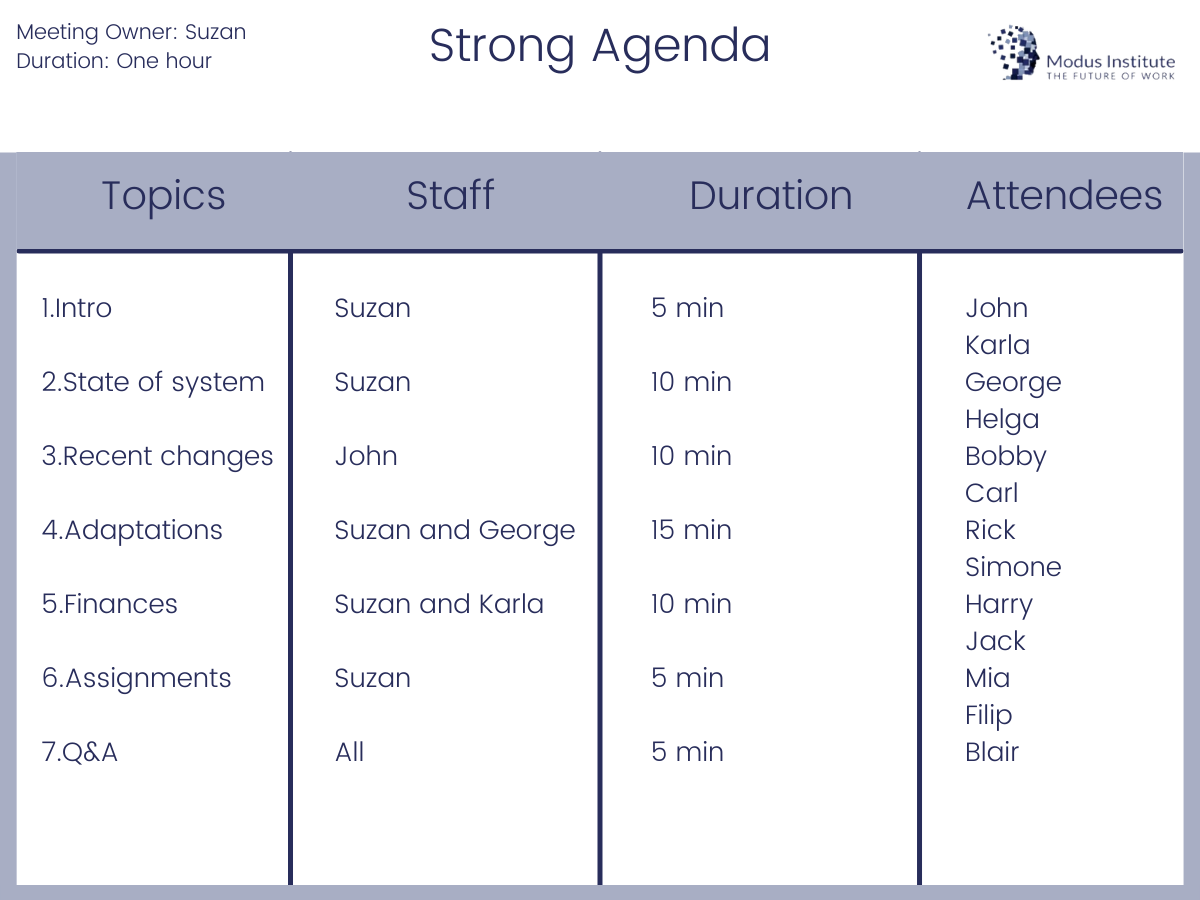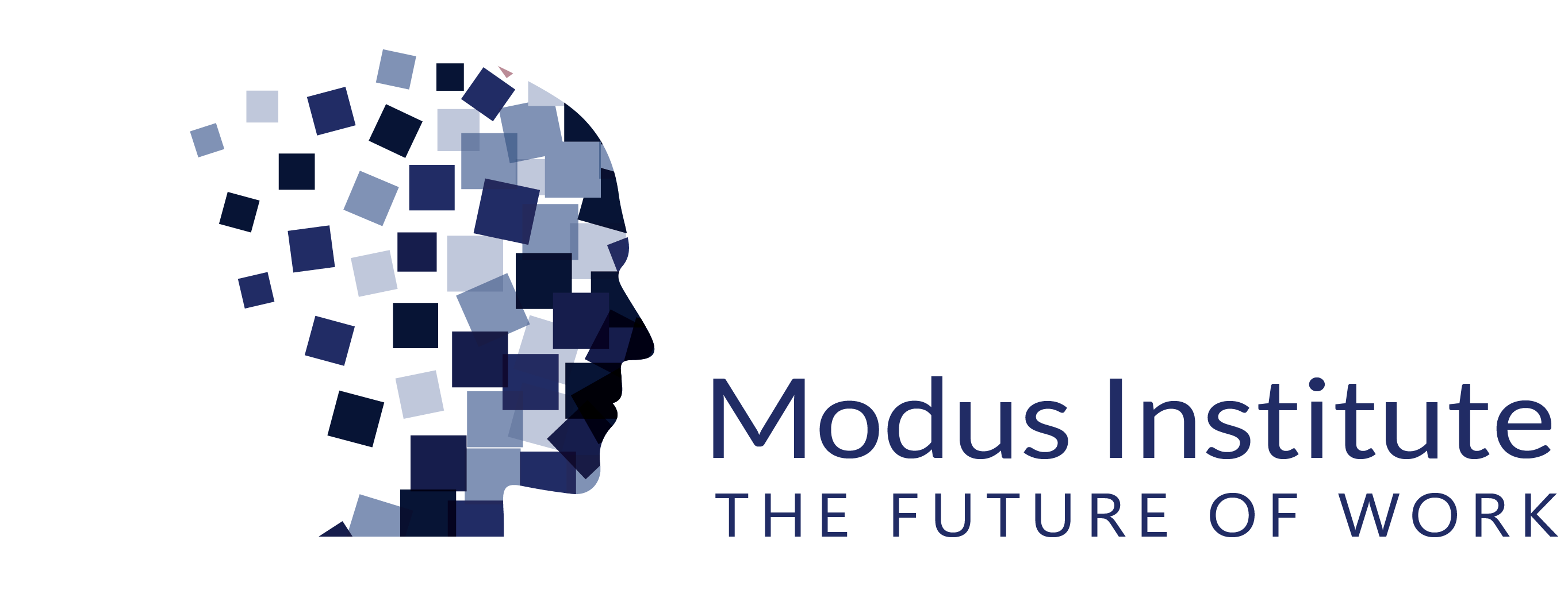Our goal should be fewer but more productive conversations. The point of any Agile meeting is to make a decision, investigate an option, or create a product. They should not be for status updates or to salve someone's ego. They should not be rituals but should serve a purpose.
Huddles are always important, but for example, Agile standups are largely about three questions - What did I do yesterday? What will I do today? What is blocking me? Their repetition, again and again, becomes worthless and doesn’t provide any value.
In short, all meetings should always have a format, a projected outcome, and should have a visualization to work with.
There’s plenty of information about Agile meetings, their rules, and formats. You can be “Agile” and still make low-quality products, have lousy meetings, and a bored team. It’s about the value, not the ritual.
For example, don’t make people answer the same three questions every single day on standup if this doesn’t add anything to the work process. With that being said, let’s explore the most popular Agile meetings and when is the time to facilitate them.
Every Agile implementation involves a few different meetings to manage and keep track of the current workload. Usually, they’re hyper-focused around a specific objective and end goal.
The main point of any Agile practice is to maximize the value and
minimize the amount of back and forth communication that isn’t relevant.
Let’s jump straight to the four most popular Agile meetings and the benefits they provide.
Selecting upcoming work is one of the most important Agile meetings. The team meets to plan what they want to accomplish by populating a Kanban board. They
prioritize the important tasks and accept responsibilities for each item. This is a key meeting that allows the team to focus and start completing work.
Daily standup meetings enable team members to be on the same page. This short Agile meeting provides updates to keep everyone aligned. The idea is to create a dedicated space to ensure transparency and collaboration among team members.
These are the most important meetings any team can have. It is generally helpful if you have a kanban or other visual system that tracks work and review it quickly in the huddle.
Since the kanban already has been telling the team who is doing what, what is finished and if anything is blocking, the huddle can be used to pair, solve problems, or raise issues, and not merely ask what people have done over the last 24 hours.
This format is very simple yet extremely powerful in terms of value. Lean Coffee is a structured Agile meeting but without a preset agenda. Participants gather, generate talking points, and begin a discussion. This way productive conversations are enabled because the agenda for the meeting was democratically generated.
This type of Agile meeting is great for reflection and introducing new improvements. The attendees are the Product Owner and the team that has been working on the past sprint or on a specific project.
Basically, they discuss what went well, what didn’t, what can be done better next time, and how to improve the state of work delivery and value. In the end, there is a good amount of action items that will be implemented into the next sprint or project. The goal of this Agile meeting is to aim for continuous improvement.
Now that we’ve covered the most applied Agile meeting formats, let’s find out their real purpose and why yours flop.
We got familiar with the typical Agile meetings like the standup, retrospective, sprint planning, Lean coffee and we’re ready to put them into action. However, the strict format that’s usually applied when facilitating them limits the team from actual conversations that solve problems.
Meetings must provide value. That’s what makes them Agile. The real purpose of getting together is to exchange ideas and turn them into action.
Effective meetings are collaborative and actionable. They serve a purpose. Teams should be able to
talk to each other, learn, and make real decisions.
We don’t make better meetings by creating strict agendas or a bunch of rules on how to behave. Too many rules are an indicator of a broken system. Allow real conversations to happen. Don’t just invite people to sit and listen.
Use structure, be respectful of everyone’s time, and learn from each other.
Strong agendas destroy value and rarely allow any conversation. In these cases, we’re forced to listen to others without offering input, stress is generated, and they make us feel put out.
Let’s imagine the following scenario: your manager is having a one-hour meeting and he invites the whole team to join. She prepared a strong agenda to follow that looks something like this:

Everyone will be mostly listening to the manager without taking an active part in the meeting. Are you starting to see the problem? This is how people become bored, annoyed, and unproductive. Now the reason why they hate such meetings is evident. Strong agendas lead to weak products. There’s just no room for discussion and collaboration.
Professionals should be able to work together in ways that solve problems, increase satisfaction, and improve. The outcome of every meeting should be based on learning and action. Let’s see how we can have better meetings that add value.
People come into meetings with the expressed purpose of leaving in a better state than they arrived. We need to help create systems that can get work done.
The results you’re going to get if you google “meeting rules” are, to say the least, disappointing. We’re human beings and we’re adults. We don’t need rules to tell us how to behave.
However, there are a few helpful guidelines that enable us to facilitate valuable Agile meetings by listening to and respecting each other without irrelevant rules restricting us from working better together.
Let's see how we can create meetings that work.
There are countless tricky situations you can find yourself in at work, home, and other social environments. Communication can be complex sometimes and we can feel attacked or confused. It really helps to assume good intentions from others.
Often, when issues or systemic failures happen, the root cause is a simple misunderstanding. For example, when you’re in the heat of the moment and someone says something upsetting, rely on positive assumptions and try to figure out where the other person is coming from. Nine out of ten times there’s nothing personal, and the problem can be solved smoothly.
That’s why it’s a great idea to assume good intent and hold back our instinctive reactions, which leads us to our next guideline.
When complex situations occur, ask questions before expressing a strong reaction. Give people a moment to reflect on their actions and elaborate on their statements. Find out what the issue is, make sure there isn’t a misunderstanding, and work your way through it by finding common ground.
It’s completely normal not to agree on everything. However, here’s the place to find where you have common ground. This is a great conflict resolution strategy for when things start to go south.
If something unexpected happens that reflects poorly on the workflow, assume that it happened because of the established system. As W. Edwards Deming said, “A bad system will beat a good person every time.” Then, find a way to
create an explicit system or some kind of agreement so you can avoid obstacles in the future.
When meetings are held in a
collaborative environment, even if there are conflicts, quality will emerge. Teams stumble on bottlenecks all the time. In these cases, members should act professionally, meet a few times, and figure out why work is slowing down. Then you create new systems or improvements to make things better. No blame, no shame, no flame, just fixing the problem.
One way to break anti-collaborative systems is by simply offering help. It’s common for teams to clash. Instead of pointing fingers, only come to the meeting with ways that you can help each other. Asking for help can still be a demand. On the other hand, offering first encourages collaboration and better work relationships. We should always ask other people how we can help. That’s what makes a meeting truly valuable.

As we see, meetings aren’t the enemy. It’s how we facilitate and perceive them that causes problems. In fact, they’re one of the most valuable practices of our work process. The way to reap maximum benefits is by assuming good intent, asking before reacting, finding common ground when needed, keeping up with a working system, collaborating to reach quality, and always offering help.
At Modus Institute, our main goal is to help professionals that seek to improve, learn, and work together. Part of the
Modus Institute Platinum Subscription is a special class dedicated to meetings that actually work and provide value.
All of the classes build a foundation for project managers, leaders, and team members to find the best ways of working possible by better communication, prioritization, and visualization. We’re here to help you make your work great again!


